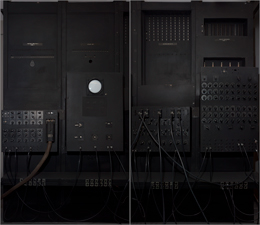
ENIAC Diptych
Developed at the University of Pennsylvania between 1943 and 1946, the ENIAC was one of the world's earliest electronic digital computers. It employed 18,000 vacuum tubes and its forty 8.5-ft tall panels filled a room 30 ft by 50 ft. Its first computational problem, conducted by Los Alamos scientists, was to determine if various mixtures of deuterium and tritium would ignite and burn, i.e., to test the feasibility of building a hydrogen bomb. These four surviving panels are currently on display at U Penn.
| 50 x 58", 40 x 46" and 15 x 17" |
| (Each size limited to an edition of 6) |